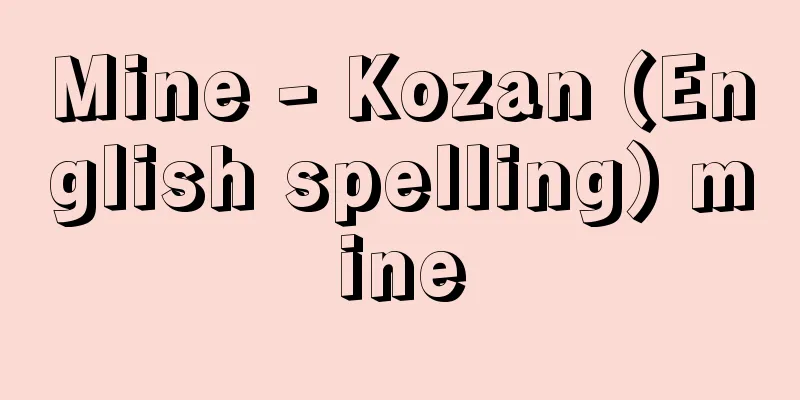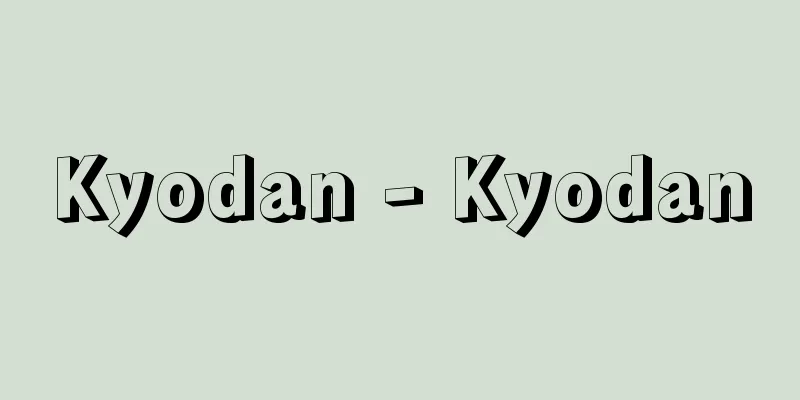Mine - Kozan (English spelling) mine

|
A general term for a business that extracts useful mineral resources from the ground. Businesses that extract coal and oil are also considered mines in a broad sense, but the former are often called coal mines and the latter ore fields to distinguish them from mines. This article mainly describes metal and non-metal mines. [Nobuo Fusamura] Mine purpose and targetAccording to the mining laws, a mine is a place of business where mining is conducted (Article 2 of the Mine Safety Law), and mining refers to prospecting, mining, and other businesses incidental thereto, such as ore dressing, smelting, and other businesses (Article 4 of the Mining Law). The other businesses referred to here are those that have the same rights holder as the mining business and are closely related to the mining business, and are determined specifically for each case. Ancillary businesses do not necessarily have to be conducted near the mine, and if most of the ore is sent from the mine, it is considered an ancillary smelter even if it is located far away. However, if the main business is smelting ore purchased from other mines or imported ore from overseas, it is not considered an ancillary business to mining. Also, if cement manufacturing or metal processing is conducted as ancillary to a mine, it is recognized as a secondary processing business and is not considered an ancillary business under the Mining Law. [Nobuo Fusamura] Legal MineralsLegal regulations and protection are necessary to develop mineral resources rationally, promote the sound development of the mining industry, and foster mines. The Mining Act regulates particularly important minerals as legal minerals, and unless an application is filed with the government to obtain the right to prospect for them (prospecting rights) or the right to mine them (mining rights), prospecting for or mining of legal minerals is not permitted. These rights are collectively called mining rights, and those who hold these rights (individuals or corporations) are called mining rights holders. In other words, only those who hold mining rights can operate a mine that mines legal minerals. According to Article 3 of the Mining Act, the following 41 types of legal minerals are designated as legal minerals. Gold ore, silver ore, copper ore, lead ore, bismuth ore, tin ore, antimony ore, mercury ore, zinc ore, iron ore, iron sulfide ore, chromite ore, manganese ore, tungsten ore, molybdenum ore, arsenic ore, nickel ore, cobalt ore, uranium ore, thorium ore, phosphate ore, graphite, coal, lignite, petroleum, asphalt, combustible natural gas, sulfur, gypsum, barite, alum, fluorite, asbestos, limestone, dolomite, silica stone, feldspar, azure stone, talc, fireclay (limited to those with a fire resistance of Seger cone number 31 or higher), and placer (gold sand, iron sand, tin sand, and other metallic ores that form alluvial deposits). When the Mining Ordinance was enacted in 1890 (Meiji 23), there were only 16 legal minerals, ranging from gold ore to sulfur, but more have been gradually added to the list due to advances in science and technology and social and economic needs. It is expected that new mineral species will continue to be added as times change. Copper minerals include native copper, cuprite, blue-and-white copper, malachite, chalcopyrite, covellite, and many others, while lead minerals include galena, cerussite, pyrosite, and pyromorphite. The same is true for other ores, and there are many types of minerals that contain specific metallic and nonmetallic elements. Legal minerals include designated ores that have economic value, regardless of mineralogy. These are determined comprehensively based on (1) the main ore and associated ore, (2) grade, (3) reserves, (4) difficulty of mining, (5) difficulty of dressing and smelting, (6) demand, and (7) convenience of transportation. [Nobuo Fusamura] Mine classificationThere are various ways to classify mines, but they are generally divided into metallic and non-metallic mines based on the type of mineral produced. Metal mines are places of business that explore, mine, dress, and refine metal ores such as gold, silver, copper, and iron, and when people simply say "mine," they usually mean metal mines. There are two types of smelting processes: smelting, in which the concentrate supplied from the dressing process is separated into crude metal and slag by melting, and refining, in which the crude metal is refined to a higher purity through processes such as electrolysis, dissolution, and chemical reactions. Some smelters attached to mines only do the former process, while others combine both. Many large mines have smelters attached to them, and some have stopped mining ore due to the exhaustion of their deposits, but in some cases the former smelters have become independent and continue to smelt ore purchased from other mines in Japan or overseas. Small and medium-sized mines mainly do mining and dressing, and sell the ore to other smelters. Metal mines are sometimes called gold mines, silver mines, copper mines, lead mines, iron mines, etc., depending on the main ore produced. In metal deposits, several metals are often produced together, so gold mines often contain silver, and copper mines often contain gold, lead, zinc, and others. These associated metals are separated during the dressing and smelting processes and supplied as refined bullion. Due to the increasing demand for existing metals with the development of industrial production and the expanding use of new metals with the advancement of science and technology, metal mines are busy expanding production, exploring for new metal ores, and improving smelting technology. New metals are also called rare metals, or noble metals, and many of them are found in small quantities in the earth's crust and difficult to refine. Examples include beryllium, gallium, niobium, cerium, hafnium, thallium, and thorium. Uranium is also a type of rare metal, and it is well known that it is explored worldwide for use as nuclear fuel in nuclear power generation, mined in large quantities, and produced as enriched uranium. Mines that produce uranium and thorium are called nuclear raw material mines, and this example shows that when demand for rare metals increases, a series of mining technologies covering exploration, mining, ore-dressing, and smelting will develop, new mines will be opened, and new metals to meet demand will be secured. Nonmetallic mines explore for and mine nonmetallic minerals such as limestone, dolomite, sulfur, gypsum, silica, alumina, and fireclay, and then beneficiate them to improve their purity or to make them uniform in particle size before supplying them as finished products. Metallic minerals are refined and supplied as pure metals, alloys, or oxides, but nonmetallic minerals are characterized by the fact that they hardly require any refining process. Sulfur ore is refined by heating and melting, which is much easier than refining metallic ores. As industrial activity becomes more active, the demand for various nonmetallic minerals increases, and nonmetallic mines are becoming larger and increasing production. On the other hand, due to the need to prevent pollution, flue gas desulfurization technology has been developed, and sulfur and gypsum can now be produced in large quantities as by-products at low cost, so some sulfur and gypsum mines that extract natural products have become economically unviable and have been closed. In terms of the type of mining, mines can be classified into surface mines (open-cut mines), where the overburden and covering rocks are stripped away and the ore is extracted from the surface, and underground mines (underground mines), where the ore is extracted from the underground ore body by using a vertical shaft, inclined shaft, or horizontal shaft from the surface. Depending on the state of the ore body, some mines use open-cut and underground mining at the same time, some mines use open-cut mining in the shallow areas near the surface and switch to underground mining at deeper depths, and some mines first mine the rich ore zones inside the mine and then open-cut mining near the surface outcrops. There are many large mines around the world that use open-cut mining for metals, non-metals, coal, etc., but in Japan, due to the characteristics of the ore deposits, large-scale open-cut mining is limited to limestone mines and the like. [Nobuo Fusamura] The uniqueness of the mineMining is quite different from other general industries in the following respects, and it is impossible to consider mining without taking these into account: [1] Mineral resources extracted from mines are finite and cannot be renewed. Therefore, it is necessary to extract them as rationally as possible. [2] Mineral resources are given by nature and cannot be created by human effort. However, through exploration efforts, unknown deposits can be discovered. [3] Mineral resources are unevenly distributed both globally and domestically, and the location of mines depends on the uneven distribution of resources. [4] Mine operations are often threatened by errors in calculating mineral reserves and fluctuations in mineral prices. [5] In mines, especially underground mines, the working space is small and there are many safety hazards such as cave-ins, explosions, fires, and floods. Japan has a small land area and therefore a small amount of mineral resources, but it has a wide variety of minerals and a long history of mining development. However, compared to other mining countries, Japan has a characteristic of having fewer large mines, especially open-cut mines. [Nobuo Fusamura] History of mine developmentEarly HistoryIt is said that the first mineral used by humans was flint. Primitive people recognized the excellent properties of flint and used it as a material for making stone tools. Many sites of Paleolithic dwellings have been discovered in flint-producing regions, and in Europe there are remains of Neolithic flint mines with primitive shafts and tunnels. The mining technology that began with the development of flint mines has been nurtured through experience and science and has continued to this day. The earliest metals used by humans, whether gold, copper, or iron, are thought to have been native metals that naturally occur in the form of metallic elements. The production of native gold and native copper is limited, and the stage of extracting them from the surface (around 3000-2000 BC) cannot be considered mining. Mineral mining in the ancient Near East was carried out in outcrops or in vertical or inclined shafts within a drainable area, and flint chisels and hammers were used in the early stages. After copper became known, copper tools were used, and from around 1200 BC, iron tools were used. The oldest widely used useful metal was copper, and therefore the oldest mine developed by humans can be said to be a copper mine. According to archaeological research in Europe, copper mine ruins from the Bronze Age have been discovered in Austria, Germany, France, Spain, Portugal, and other countries. Tyrol in Austria flourished as a copper mining center from around 1600 BC to 800 BC. In the Roman period, some records of exploration, mining, and refining techniques remain, and the remains of mines and refineries have been discovered. During this period, large-scale mining began, with tunnels dug and tunnels opened to excavate underground deposits. German scientist Agricola's De Re Metallica describes the mining industry in detail in the 16th century, covering everything from production techniques such as exploration, mining, and refining to mine hygiene and management, and this book brings together mining technology as a systematic science and technology. Italian physician Bernardino Ramazzini (1633-1714) wrote De morbis artificum diatriba , which reports on various occupational diseases in the mines of the time and warns about disease prevention measures for miners involved in the extraction of minerals, an important national project. Around 1700 B.C., the Hittites used iron weapons and chariots to conquer the Oriental countries of the Bronze Culture and built a great empire. The historical facts of the Hittites' iron ore exploitation remained unknown for a long time, but in recent years, the remains of an ironworks and iron slag from that time have been discovered in the Anatolia region of Turkey. [Nobuo Fusamura] ChinaAccording to historical records, copper mining began before the Three Sovereigns and Five Emperors period, and copper was produced in Henan Province during the Yellow Emperor period, but this remains a legend. During the Xia, Yin, and Zhou dynasties (2000-250 BC), gold, silver, and copper were used, and weapons were also made of copper, but during the Qin dynasty (246-207 BC), iron production began, and there are records of active mining of iron ore. Furthermore, during the Han dynasty (202 BC-220 AD), demand for copper and iron increased. In the 1970s, the remains of a Han-dynasty copper mine were excavated at Tonglu Mountain in Daye County, Hubei Province, and tunnels with wooden supports, 40-50 meter deep shafts, mining tools made of wood, copper, and iron, and the remains of a copper smelting furnace were discovered. It is estimated that the mine produced approximately 80,000 tons of copper by the time mining was discontinued. In ancient China, there was no government protection for mining production, and mining was often banned due to superstition or government policy, hindering the healthy development of the mining industry. During the Tang (618-907) and Song (960-1279) dynasties, the variety and quantity of metals produced increased significantly. During the reign of Emperor Renzong of the Song dynasty (reigned 1022-1063), mining flourished to the point that it was causing a decline in agriculture, and the mines were temporarily closed. As a result, there were an abundance of unemployed miners, which became a social problem, and it is said that the mines were reopened. Song Yingxing's "The Creation of Heaven" (1637), published at the end of the Ming dynasty, introduces the mining and refining techniques used at the time. In the 20th century, when Western powers advanced into China at the end of the Qing dynasty, it was realized that the country could not prosper without mining development, and for the first time the path to modernization of the mining industry was opened. Since the founding of the People's Republic of China in 1949, new mine development has been promoted all over China, backed by vast underground resources, in order to supply the resources necessary for industrialization. [Nobuo Fusamura] JapanThere are descriptions of mining and refining in the Age of the Gods in the Kojiki and Nihon Shoki, but these were probably borrowed from the technical knowledge of Yamato and Nara periods when the Kojiki and Nihon Shoki were written. Early mining developed after traffic with Korea became active around the 3rd century and mining engineers began to arrive in Japan. From this period onwards, there were many records of mineral discoveries, such as fuel oil (petroleum) and fuel clay (asphalt) being presented to the Imperial Court from Echigo in 668 (7th year of Emperor Tenchi's reign), silver being discovered for the first time in Tsushima in 673 (2nd year of Emperor Tenmu's reign), and silver being presented from Iyo in 691 (5th year of Empress Jito's reign). In the Taiho Code (701) of Emperor Mommu, both public and private mining of copper and iron was permitted, and mining production was actively encouraged. In the year 708 (Wado 1) of Emperor Genmei, native copper was discovered in Chichibu County, Musashi Province, and to commemorate this, the era name was changed to Wadou, and copper coins were minted and inscribed with the Wadoukaichin coin. The three discoverers were given the rank of Junior Fifth Rank, and the Imperial Court showed great hospitality in the discovery of native copper, granting tax reductions and exemptions for Musashi Province and Chichibu County, amnesty, and gifts to the elderly. Emperor Gensho's Yoro Code (718) established the Shokudo Law, which allowed people to atone for their sins by paying copper, further stimulating the development of copper mining. The main mineral products at that time were copper, gold, silver, iron, tin, lead, antimony, cinnabar, orthorhombi, and mesocarp. Some of the mining and refining techniques of the time are known, but little is known about the scale of the mines and the actual management of the mines. In any case, the so-called "tanuki digging" method, in which only the outcrops of the deposits were mined, was common. Japan's mining industry was established from the late Middle Ages to the early modern period, and the development and management of mines came to determine the rise and fall of politics and power. After unifying the country, Toyotomi Hideyoshi conducted land surveys and established a land system, nationalized all mines nationwide (around 1548), and placed magistrates at important mines under the direct control of the Toyotomi family. During this time, new mines were developed all over the country, and gold and silver were produced in large quantities, leading to the Toyotomi family possessing large amounts of gold and silver. In the Edo period, Tokugawa Ieyasu also maintained the nationalization of mines, calling the directly controlled mines Ojikiyama (directly controlled mountains), and requiring miners to pay tax (tax based on the amount of mineral production) from mines that he entrusted with mining, which were called Unjoyama (directly controlled mountains) or Jibunyama (directly controlled mountains). In order to encourage mining, the "Mountain Reform Act 53" (1588) was enacted, which allowed prospectors to use their surnames and carry swords, and other privileges were given to them, encouraging active development of mines. As a result, many promising mines were discovered, strengthening the economic foundation of the shogunate. Many mines were discovered during this period and have continued to operate until recently. Examples include the mines in Osarizawa (Akita Prefecture), Ikuno (Hyogo Prefecture), Hosokura (Miyagi Prefecture), Kamioka (Gifu Prefecture), Hitachi (Ibaraki Prefecture), Sado (Niigata Prefecture), Ashio (Tochigi Prefecture), Besshi (Ehime Prefecture), and the Miike Coal Mine (Fukuoka Prefecture). From the mid-16th century to the end of the 17th century, the amount of silver exported from Japan to the Netherlands and China averaged 50 tons per year, with a peak of 117 tons, and records from 1685 (Jokyo 2) show that there were 34 operating copper mines, with copper production exceeding 6,000 tons, of which one-ninth was consumed domestically, and the rest was all exported. Records indicate that there were approximately 200,000 copper mine workers at the time, approximately 100,000 charcoal burners for refining, and approximately 10,000 smelters (The History of the Development of Japanese Mining, Vol. 1, 1932, edited by the Mining Forum). During the Edo period, many mining technical books were published. Kurosawa Motoshige's "Mine Treasures Summary" (1691) describes mining work in general, Shimohara Shigenaka's "Tetsuzan Hisho" (1784) describes the mining and refining of iron sand, Akaho Mitsunori's "Mine Records" (1785) describes surveying, mining, and refining, Masuda Tsuna's "Kodo Zuroku" (1801) describes the mining and refining of the Besshi Copper Mine, Sato Nobuhiro's "Yamaso Hiroku" (1827) describes prospecting techniques, and "Kojo Horitsu" (1827) describes mine management. Mining promotion policies were actively implemented, and some Western technology was introduced, but as the mines got deeper, technical measures such as drainage and ventilation became more difficult, and more mines were abandoned, resulting in little progress in increasing mineral production. It was after the Meiji Restoration that Japanese mines took on a modern corporate form. Important mines were placed under direct government control, and modernization was attempted by introducing foreign technology through the guidance of employed foreigners and the dispatch of students to Europe. From the mid-Meiji period, they were sold to private conglomerates. Since then, they have been supervised and guided by the government and the efforts of private companies, but many difficult problems are imposed on Japanese mines, which develop resources in the complex geological conditions of a small country. Many mines that have continued for hundreds of years since the early modern period have been forced to close in recent years due to the depletion of ore reserves and rising production costs. On the other hand, promising deposits have been discovered and new mines have been opened thanks to the development of exploration technology and detailed wide-area resource surveys conducted by the public and private sectors, but this is not enough to meet the demand for minerals in Japan, an industrialized country. We are now in an era where we must utilize the mining technology that has been honed under Japan's complex geological and deposit conditions internationally, such as by simply purchasing ore from resource-rich countries overseas, purchasing ore in return for technical cooperation, investment, and loans, or acquiring rights and developing independently. [Nobuo Fusamura] Modern mining developmentWhen a deposit containing enough useful minerals to be economically viable is discovered, a new mine is developed there. If the deposit is large and has abundant reserves, a large mine will be developed. To develop a new mine, the existence of the deposit must first be clearly understood through geological surveys, geophysical surveys, geochemical surveys, and test drilling. This takes 3 to 5 years, depending on the size of the deposit. In parallel with this, samples are collected by drilling or test tunnels and analyzed to determine the grade and amount of the ore. These results are then comprehensively examined, along with the accessibility to the nearest city or port, the natural and living environment of the area where the deposit is located, and a mine evaluation and profit calculation are carried out to determine whether it is worth developing and, if so, what scale would be appropriate. This stage is called a feasibility study, and it takes 5 to 8 years from the start of exploration to this stage. Once the development policy has been decided, the safest and most advantageous mining plan is established based on the actual state of the deposit and future prospects, and then detailed consideration is given to whether open-cut or underground mining should be used, and if underground mining is to be used, whether a vertical shaft, inclined shaft, or tunnel should be used, as well as the mining method, excavation method, transportation method, and other conditions necessary for operation. Regarding the dressing and smelting of the mined crude ore, consideration is also given to whether to process it on-site or sell it. With these plans, the mine's lifespan is set at at least 10 years, and development begins based on the final plan. The development of a new mine requires not only facilities inside and outside the mine necessary for direct mining operations such as ore extraction, ore dressing, and smelting, as well as various mine pollution prevention facilities, but also electricity, water power, pit timber, and various materials supplies, transportation facilities such as roads, railways, and ports, and various facilities necessary for the daily life of mine employees, such as daily necessities distribution centers, schools, hospitals, and temples. In Japan, if the mine is located near an existing mine or near a city or village, these existing facilities can be used as is, or only need to be expanded or renovated to a certain extent, but in remote mountain areas, considerable capital investment is required prior to mine development, such as building roads, laying power lines, and creating a living environment for employees. The social facilities necessary to operate a mine are collectively called infrastructure. When developing a new mine in a resource-rich country overseas, the cost of infrastructure construction out of the total construction cost is only about 3 to 5% in developed countries such as Canada and Australia, but in Africa, South America, Southeast Asia, and other areas, it can be as much as 10 to 30% or more. When a new mine is developed and the surrounding infrastructure is improved, people other than mine employees and their families gradually gather and live in the area, forming a mining village. If the mine continues to grow larger, the village also develops into a village, and then develops further into a mining town. Examples include Hitachi Mine and Hitachi City, Besshi Mine and Niihama City, and Miike Coal Mine and Omuta City. However, underground resources are finite and will disappear once they are all mined, so even if it is a large mine, if new deposits cannot be found by exploration inside and outside the mine, it will eventually have to close. Unless there is another industry that contributes to the development of the area, mining villages or mining towns will decline with the closure of the mine, and in some cases may disappear. In Japan, some cities continue to thrive as industrial or commercial cities even after mines or coal mines have closed, but there are many cities that have seen their population halve and are suffering from depopulation. In California, a place once bustling with gold dust mining, ghost towns have turned into ghost towns due to the depletion of gold dust, but have recently become tourist attractions. In Japan, mines that were no longer mined have been revived as tourist sites, such as Sado, Ikuno, and Toi (Shizuoka Prefecture). Closed mines have their entrances sealed to prevent people from entering, and there are also cases where underground cavities are used for special experiments, storage, or waste disposal. Depending on the nature of the deposit, there are cases where acidic water or water containing heavy metals continues to flow out of the mine even after the mine has been closed. In such cases, the previous mining rights holder, the national government, and local governments are required by law to take measures to prevent water pollution. When an open-cut mine is closed, measures to prevent danger and protect the environment, such as backfilling the mined area and revegetating the area, are necessary. This is called reclamation, and has become especially important since the protection of the natural environment became an issue. [Nobuo Fusamura] Mine workExplorationIt goes without saying that new mines cannot be developed without discovering promising deposits and securing reserves through exploration, but even in developed mines, exploration activities must be continued as part of daily mining operations, both inside the mine and in and around the mining area, to confirm the existence of deposits and increase confirmed reserves. It is desirable for operating mines to discover new reserves through exploration that exceed the amount of ore extracted in a year. When exploration results have almost stopped, it means that the mine's lifespan is approaching its limit. The reason why mines discovered and developed in Japan in the 16th and 17th centuries continued to operate until recently is not because they had discovered such a large amount of ore from the beginning, but because they continued to make exploration efforts while mining. The discovery of new deposits through the development of exploration and test drilling technology should also not be overlooked. With the development of technology that can accurately discover deep deposits, it has become easier to find hidden deposits deep underground, and there are many cases in which promising deposits have been discovered in areas where no deposits were previously thought to exist. In an operating mine, in addition to the current mining face, the next mining face must be prepared. This involves digging tunnels into the deposit that has been confirmed in advance by geophysical surveys and test drilling, determining the mining area based on the mining plan and the actual condition of the ore body revealed by tunnel excavation, and completing the preparation of the face. In the case of a vein-like deposit, tunnel excavation is carried out by following the vein in the mine, and when a thick, developed vein is found, preparations for mining can be made. In mining terminology, a vein is called a hi, and a tunnel excavated along the vein is called a hi tunnel. The part where the vein is developed is called an ore-rich zone or bonanza (meaning a big hit). Hi tunnels and tunnel exploration are carried out with the aim of discovering these bonanzas. [Nobuo Fusamura] miningOnce an ore deposit has been extracted, it cannot be regenerated, and it is generally impossible to recover anything left over from mining, except in the case of mining methods that involve planned pillar recovery. Therefore, ore should be extracted as completely as possible, but this is difficult due to the constraints of being profitable and safe. The general principle is to select a mining method that is safe, profitable, and has the highest possible recovery rate. Therefore, sometimes only 40-50% of the ore reserve is extracted. Mining methods vary depending on the characteristics of the deposit, ore, and host rock, as well as the planned mining volume. Open-cut mining is safer than underground mining, has lower mining costs, and has a higher recovery rate, but it can only be used when the deposit is shallow and the overburden is relatively thin. Recently, social demands and legal regulations regarding the protection of the natural environment and the prevention of pollution have become stricter, so open-cut mining is often restricted. To mine ore efficiently underground, it is necessary to consolidate the working faces as much as possible to increase the amount of ore produced per working face and to shorten the length of the maintenance tunnels. Mechanization is necessary to make mining work safer, cheaper and more productive, but mechanization is difficult when vein deposits and small scale masses are dispersed. Large mass and layered deposits are being carried out in Japan as well. New technologies such as artificial ridges are being adopted in the Kuroko deposits to ensure safety against soft rocks and improve actual yield. In order to lower the mining cost, new technologies must be introduced and productivity improvements by increasing production, but the mine has the optimum amount of mining amounts according to the amount of minerals held, and increasing production without securing new minerals through exploration will shorten the lifespan of the mines, which is a problem in management. There are some parts of the deposits that are both good and bad, so the crude mineral quality is adjusted to take into account fluctuations in the market price of mineral products, and in times of good economic conditions, even low grade ores are mined in times of recession, and in times of recession, high grade ores are mined. In addition, if the grade of crude minerals mined every day changes significantly, it has a negative effect on the actual yield of mining, so the amount of mining is adjusted according to the grade of cut-off. If the rock in the mine is solid, the unfilled mining method can be used to leave the mining site hollow. In such cases, it is not possible to leave the excavated mine as a bare mine without supporting support. If the rock is collapsed or there is a risk of causing problems with surface subsidence, the fill mining method must be adopted and the mine shaft must be properly supported. Main mine shafts are wound steel frames and concrete, but the Hi-Oshi mine shafts are often supported by wood mines. [Nobuo Fusamura] TransportationEven if productivity increases as mining is improved in the faces, if the production of transportation systems is not improved, and transportation is streamlined and faster to meet this rate, the overall productivity cannot be achieved. The transportation plan must be decided by taking into account not only the removal of mined ore, but also the transport of materials and personnel, and the delivery of filling materials. In open-pit mining, locomotive transport by rail-type mining vehicles in the horizontal section and rope transport by incline (slanted mines) are used appropriately, but recently, many methods have been used to carry locomotives such as dump trucks without laying rails, loading them with a loader or power shovel using a cutting edge, and transporting them from the cutting edge to a surface mine mine or mining station. In underground digging, roughly divided into three types: cutting edge transport, horizontal shaft transport, and tilt or shaft transport. There are many types of cutting edge transport methods, and although there are limits to the transport methods that can be implemented through the mining process, there are gradually more capacity and higher efficiency. Horizontal mine transport is carried out in areas with a small amount of mine, or a storage battery-powered locomotive (abbreviated as battery loco) towing a mineral vehicle with a capacity of about 1 ton (abbreviated as battery loco) in areas with a large amount of mine, and a mineral vehicle with a capacity of 5 tons or higher is towed by an overhead loco (abbreviated as trolley loco) or using a belt conveyor. In cross mine transport is carried out by a winding machine on the top and a train with a rope that has been formed by a train with a mineral vehicle formed by a rope. When using a belt conveyor, it is preferred because it can be transported continuously from a major horizontal shaft through an inclined shaft to an outside mine facility.になったんです。 English: The first thing you can do is to find the best one to do. [Nobuo Fusamura] Ventilationになったんです。 English: The first thing you can do is to find the best one to do. In the past, natural ventilation was abundant in metal mines, but due to the transition of the faces deep, the increase in mining volume, and the introduction of diesel vehicles using the truckless mining method, the rise in underground temperatures, the contamination of the underground air has increased, and mechanical ventilation has increased. High-temperature workshops that cannot be sufficiently cooled by circulating air vents alone are cooled underground using cooling equipment. Advanced techniques are required to supply the required airflow to each complex underground work site. Calculations regarding the ventilation flow in a tunnel are called ventilation network analysis, and solutions are calculated using a computer based on the actual measured value of tunnel resistance. In addition to the generation of harmful gases from rocks and mineral deposits in the mines, the generation of carbon monoxide, carbon dioxide, nitrogen oxides, etc. from blasting operations, the generation of sulfur dioxide and hydrogen sulfide from mineral water, and the consumption of oxygen due to oxidation of the mineral, etc. can cause stagnation of harmful gases or oxygen deficiency in areas with poor ventilation, which could cause employees to become poisoned or suffocated. Furthermore, if fine dust that occurs due to mining or rock and floating in the air is inhaled, there is a risk of contracting pneumoconiosis over a long period of time, so hygiene regarding ventilation must be taken with great care. [Nobuo Fusamura] DrainageSprings are an accustomed to mining underground resources. In pre-modern mines, although there were sufficient amounts of mines, they were abandoned because they could not drain. Even in modern mines, underground water has increased as the faces are moved deeper, and pumping pumps have become larger and more pump stations are needed. Recently, the capacity of the water tank at the bottom of the mine has been increased, so pumping is automated when the water level in the tank reaches a certain level, or pumping water using night electricity, which consumes little power related to production, which is low in the cost. In the past, pumps were always placed in the pump room, but recently there are many cases where personnel are not in attendance except for regular inspections. Mineral water (submersible water) is not uniform throughout the year, and increases during the snowmelt or rainy season, and torrential rainfall can cause the open-pit wings to collapse, submerge, or rainwater into the mines. Mines' pump equipment must have enough capacity to treat spring water during these rising seasons. Since mineral water is highly acidic and often contains a large amount of heavy metals, salts, sediment, etc., water pumped outside the mine is not permitted to be released into public rivers unless it is treated with mineral water according to its properties. The same treatment is required for wastewater from the mineral selective plant and water flowing from the rubble deposition field. If there is a large amount of copper ions in the mineral water, iron scraps are placed and the precipitated copper is collected by ion exchange. [Nobuo Fusamura] illuminationLighting is essential in mines, which are underground work. In metal mines, in the past, dry bamboo shoots and other torches were used as torches, and then burning flames from animal and vegetable oils. However, in the 20th century, acetylene gas lamps made from carbide have been used for a long time under the name Cantera. The Cantera is small, lightweight, and is quite bright, and has the advantage of turning off the lights in areas where oxygen is not easily generated in poor ventilation, signaling danger. However, in most mines, employees carry battery-powered cap lamps, and floodlights are equipped with work sites such as mining and excavating wings, and fluorescent lamps are equipped with fixing fluorescent lights at main mines, making the work environment safe and easy to work. [Nobuo Fusamura] Mineralization and smeltingOres mined through mining faces are called crude ores, and in addition to the ore, they are mixed with ganstone, which is a valueless part of the deposit, and part of the surrounding host rock, and the size of the ore is indistinguishable. In some cases, the ore is an aggregation of various minerals, and may contain several metal components. At the mineral selection site, the ore is removed through processes such as crushing, sieve, grinding, classifying, and flotation of the crude ore, and the grain size is adjusted, and the concentrate is made by metal components. Separating ores made up of complex mineral compositions by metal components is the central theme of bene-selection technology, and delicate technical considerations are required for each ore's properties. As the grade and ore composition of crude ore supplied to the mineral selection site changes immediately, it is necessary to manage the grade and composition of the mineral supply to be almost constant. Large-scale mines manage crude and mineral supply using computers. In non-metal mines, the bene-selection process is generally simple, with the grain size being adjusted by grinding and sieving to be made into concentrates, and they are shipped as a product as is, or as a secondary product in the processing department. Metal ore concentrates are smelted at smelters and shipped as bullion or oxides or other products required in secondary industries. Large mines often have direct smelters, but small and medium-sized mines generally sell selected concentrates to smelters, or crude ore to other mines. In Japan, even smelters attached to mines are insufficient for their own ore, so many cases are bought and smelted from other mines and smelted from other mines. [Nobuo Fusamura] Attached facilitiesIn order to smoothly carry out mining operations, in addition to mineral picking plants and smelters, various equipment such as workshops, pressure air chambers, winding machines, power receiving stations, substations, materials warehouses, concentrate storage facilities, offices, etc., as well as underground stones, selectable waste stones, smelting slags, and dams for mining slime slime (floating fine waste stones). When filling and mining is carried out in the mine, the selectable waste stones and slime are sent back to the mine as filling materials. In addition, waste stones can be used as construction aggregates, and secondary products using slag and slime as raw materials, and the amount of rubble can be reduced. Research and development and product factories for effective use of these unused resources may be carried out jointly by not only one mine, but also by several local mines. [Nobuo Fusamura] Mining and economicsMining evaluationMining work is like taking goods out of warehouses, and as the mineral mining progresses, the amount of mine decreases, and the more mining work continues, the more the mine value decreases. In this respect, it is different from general manufacturing and transportation and communications industries, where assets do not decrease as work continues. In mines, assets (mining amount) decrease year by year, and after a certain period of time it reaches zero. In reality, they are striving to discover new amounts of mine through exploration efforts, but the known amount of mine is destined to be mined in time. If a mine sells its mineral products, it means that it is selling its assets, so it should not be entirely made into a real profit, but rather that part of the capital it originally invested has returned. In other words, the mine's annual revenue should be considered as the sum of the true profit and the amortization of capital. Another issue is how long the lifespan of mines lasts. This is determined from the amount of minerals, annual ore output and actual yield. Furthermore, mining has the characteristic of having more dangerous factors than other companies. These include production-related risks, such as differences in the quality of ore, production costs, mineral prices, demand, etc., and fatal safety damages such as fires, explosions, water runs, falls, collapses, etc. It is desirable to continue operations without causing these risks, but in the unlikely event, mining investment must expect to provide a profit greater than the investment yield in general industries as a compensation for these risks. This can be considered as insurance for the risks of mine management. If a certain investment is made and a promising deposit is not discovered and it is determined that development is not worth it, exploration investment up to that point is completely useless. Moreover, such things can often be seen in mining development. になったんです。 English: The first thing you can do is to find the best one to do. The annual production of minerals is multiplied by profit per tonne and then multiplied by the life of the mine, the total amount of profits that will be obtained from this mine. However, in order to convert future profits to current value, it must be discounted under a certain yield rate. Two formulas have been proposed for present valuation for such mines: [1] Inwood Official [2] Hoskold official Mining evaluation is necessary not only when mining companies independently develop their own domestically, but also when acquiring other mines that have already been developed or undeveloped mining areas, but also when investing in overseas mines, internationally-level mining contracts, etc. When investing in and purchasing or purchasing overseas mines with different national conditions and deposit conditions, thorough preliminary investigation and quick and reliable mine evaluation are required. A system has been developed that uses a computer to create mining evaluation materials at the initial feasibility study stage that will accurately and quickly lead to investment profitability. [Nobuo Fusamura] Mining makeupWhen buying and selling small and medium-sized mines, unfair means can make a low-value mine look like a promising mine. This includes the following methods: [1] Mix high-grade ore into the analytical sample. When collecting an analytical sample from a deposit, the seller may use clever means to mix high-grade ore into the buyer's sample. [2] Planting ore. Large ore is brought into the surface of the earth with no empty space and makes it look like an outcrop. Artificial veins are created at the tip of a mine shaft with no veins and ore is planted. [3] High-grade ore is applied to the veins. Use a gold mine ore to mix gold dust with clay and apply it to the veins. [4] Hide the mining traces. Excavate the minerals in the back, surrounded by mine shafts, and leave the mine shaft walls to make it seem like there is plenty of mineral content. [5] Gives an illusion. A mine tunnel is set up so that the veins can be seen more broadly than they actually are. [6] The underground map is bullshit. The underground map must accurately include mines, veins, faults, mining sites, etc., but these can be bullshits. [7] Guide to adjacent mining areas. You can guide them to outcrops in other mining areas that are not in their own mining areas, or guide them through the mines of adjacent mining, making them think that the mining conditions of the adjacent mines are good, so they are also good to continue with the ones that follow. [8] Exaggerate the history of the mine. They exaggerate and mislead the mine status, saying that it was a mine that was frequently mined during the Warring States period. [9] Tamper with the investigation report. Tamper with the expert's investigation report in a convenient way, or have the expert's investigation report be prepared. [10] The mining area or mine is in the name of someone else or is mortgaged. These fraudulent acts attempt to unfairly sell a mine for a high price is called mining cosmetics. [Nobuo Fusamura] The rise and fall of the mineBecause underground resources are limited, the lifespan of mines is limited. Mines are mined and explored nearby areas to constantly discover new deposits. However, even if they try hard, they will no longer be able to find promising deposits. This can be said to be not just one mine, but also within a region, or even a country. Japan is said to be a small resource country and is thought to have few underground resources, but it was developed earlier than most current resource countries. It was once known as the golden country of the East around the 13th century, and was actively involved in industry from the 15th to 16th centuries, contributing to the development of society and exporting copper and other substances to Europe. Japan was a transitional country, but it was once a resource country of the world. The rise and fall of mines in Japan over the last 50 years has undergone dramatic changes. The decline in coal mines and metal mines is due to the depletion of underground resources and the deterioration of underground conditions that cannot be solved by technology. Conversely, the trend of increased production in limestone mines is due to the abundance of limestone resources, rapid improvements in technology, and advances in rationalization. This trend is expected to continue for a while. The shortage of coal and metal minerals is reliant on imports from overseas. Many European developed countries have entered a period of decline in domestic mines, but not only developed countries but also developing resources, as the world economy develops, new mines and production increase trends have generally continued, with the development of new mines, and the amount of major mineral products in the world is gradually increasing. [Nobuo Fusamura] "Mine Reader" Supervised by Shimomura Yataro, Nakano Minoru, and Saito Heikichi" 65 volumes (1959-1967, Jitsugyo Shoin)" ▽ "Yamada Fukunosuke and Sakai Kenji, "Development and Management of Mines" (1963, Jitsugyo Shoin)" ▽ "Kobada Jun, "Sequel to the History of Japanese Mines" (1986, Iwanami Shoten)" ▽ "Ogata Otomaru and Koyama Ichiro, "Japanese Mines (Revised)" (1989, Uchida Rotsuruho)" [Reference Items] | | | | | | | | |Tools used in mining during the Edo period. It depicts tools necessary for mining, transporting, draining, etc. "Nihonzan Sea Specialty Diagram" Volume 1 "Kanayama Tools" Collection of the National Diet Library "> The mine harvesting mentioned in the "Japan Mountain Sea Specialty Diagram"... Ikuno Silver Mine. Ikuno Town, Asago District, Hyogo Prefecture (now Asago City). "Photo Collection of Famous Japanese Scenic and Historical Industry, Kinki Regional Section" (1918 Taisho 7) held by the National Diet Library "> Ikuno Mine (Taisho period) Hitachi Village, Taga District, Ibaraki Prefecture (now Miyata-cho, Hitachi City). "Photo Collection of Famous Japanese Scenic and Historical Industry, Kanto Regional Section" (1918 Taisho 7) held by the National Diet Library "> Hitachi Mine (Taisho period) Ashio Town, Kamitsuga District, Tochigi Prefecture (now Ashio Town, Nikko City). "Amazing Scenic in Japan" (1900 (Meiji 33)) held by the National Diet Library "> Ashio Copper Mine (Meiji Period) [Former Kosaka Mine] It has one of Japan's leading black mineral deposits, and since its discovery in 1861 (Bunku 1), it has produced useful metals such as gold, silver, copper, lead and zinc. As it is a flat mineral selection plant, it has advantages in terms of factory management and material delivery, and operation with a small number of personnel was also one of its major features. Closed in 1990 (Heisei 2) © Shogakukan "> Schematic diagram of the mine (underbolt digging) Source: Shogakukan Encyclopedia Nipponica About Encyclopedia Nipponica Information | Legend |
|
地中に存在する有用鉱物資源を採掘する事業場の総称。石炭や石油を採掘する事業場も広い意味では鉱山であるが、前者は炭鉱、後者は鉱場と称して鉱山とは区別することが多い。ここでは主として金属・非金属鉱山に関して記述する。 [房村信雄] 鉱山の目的と対象鉱山関係法規によれば、鉱山とは鉱業を行う事業場をいい(鉱山保安法2条)、鉱業とは鉱物の試掘、採掘およびこれに付属する選鉱、製錬その他の事業をいう(鉱業法4条)。ここでいうその他の事業とは、採掘事業と権利主体を同じくし、鉱物の採掘事業と密接な関係のあるもので、個々の場合に具体的に決定される。付属事業はかならずしも鉱山の付近で行われることを要せず、鉱石の大部分がその鉱山から送られている場合は、場所が遠く離れていても付属製錬所とされる。しかし主として他の鉱山からの買鉱ないし海外からの輸入鉱を製錬している場合は鉱業の付属事業とはされない。また鉱山に付属してセメント製造や金属加工を行っている場合は、二次的加工業と認められ、鉱業法上の付属事業とはされない。 [房村信雄] 法定鉱物鉱物資源を合理的に開発し鉱業の健全な発達を図り鉱山を育成するためには、法的な規制と保護とが必要である。鉱業法では、とくに重要な鉱物を法定鉱物として規制し、国に出願してこれを試掘する権利(試掘権)または採掘する権利(採掘権)を得ない限り、法定鉱物の試掘、採掘は許されない。これらの権利を総称して鉱業権といい、この権利を有する者(個人または法人)を鉱業権者と称する。すなわち、鉱業権者でなければ法定鉱物を採掘する鉱山を経営することはできない。鉱業法第3条によれば法定鉱物とは次の41種である。 金鉱、銀鉱、銅鉱、鉛鉱、蒼鉛(そうえん)鉱、錫(すず)鉱、アンチモニー鉱、水銀鉱、亜鉛鉱、鉄鉱、硫化鉄鉱、クローム鉄鉱、マンガン鉱、タングステン鉱、モリブデン鉱、砒(ひ)鉱、ニッケル鉱、コバルト鉱、ウラン鉱、トリウム鉱、燐(りん)鉱、黒鉛、石炭、亜炭、石油、アスファルト、可燃性天然ガス、硫黄(いおう)、石膏(せっこう)、重晶石、明礬石(みょうばんせき)、蛍石(ほたるいし)、石綿、石灰石、ドロマイト、珪石(けいせき)、長石、ろう石、滑石、耐火粘土(ゼーゲルコーン番号31以上の耐火度を有するものに限る)および砂鉱(砂金、砂鉄、砂錫その他沖積鉱床をなす金属鉱をいう)。1890年(明治23)鉱業条令が制定されたときの法定鉱物は金鉱から硫黄までの16種にすぎなかったが、科学、技術の進歩と社会的・経済的必要性から漸次追加され現在に至っている。今後もまた時代とともに新しい鉱種が追加指定されるものと考えられる。 銅を含む鉱物には、自然銅、赤銅鉱、藍(らん)銅鉱、孔雀石(くじゃくいし)、黄銅鉱、銅藍その他多数あり、鉛を含む鉱物にも、方鉛鉱、白鉛鉱、硫酸鉛鉱、緑鉛鉱など多数ある。他の鉱種についても同様で、特定の金属・非金属元素を含む鉱物が各種ある場合が少なくない。法定鉱物は鉱物学上の鉱物種にかかわらず、指定鉱種を含み経済的価値をもつ鉱石を対象としている。これらは、(1)主体鉱石および随伴鉱石、(2)品位、(3)埋蔵量、(4)採掘の難易度、(5)選鉱・製錬の難易度、(6)需要、(7)運輸交通の便、などから総合的に決定される。 [房村信雄] 鉱山の分類鉱山の分類方法はいろいろあるが、一般には鉱産物の種類により金属鉱山と非金属鉱山とに分けられる。 金属鉱山は、金、銀、銅、鉄などの金属鉱石を探査、採鉱、選鉱、製錬する事業場で、単に鉱山という場合は金属鉱山を意味する場合が多い。製錬工程は、選鉱工程から供給される精鉱を融解などによって粗地金(あらじがね)と鉱滓(こうさい)とに分ける製錬smeltingと、電解、溶解、化学反応などの工程で粗地金の純度を高めた地金とする精錬refiningとがある。鉱山付属の製錬所のなかには前者の工程だけのものと、両者をあわせて行っているものとがある。大鉱山では製錬所を併置している例が多く、なかには鉱床が枯渇して鉱石の採掘は中止されたが、かつての付属製錬所は独立して国内他鉱山または海外から買鉱して製錬を続けている例もある。中小鉱山は主として採鉱と選鉱だけを行い、他の製錬所へ売鉱する。 金属鉱山は、産出する主要鉱石によって、金山、銀山、銅山、鉛山、鉄山などとよばれることがある。金属鉱床では数種の金属がいっしょに産出する場合が多く、金山でも銀を伴い、銅山でも金、鉛、亜鉛その他を伴うことが少なくない。これら随伴金属は選鉱および製錬工程で分離され、それぞれの精製地金として供給される。工業生産の発展に伴う既存金属に対する需要増大と科学、技術の進歩に伴う新金属の利用拡大により、金属鉱山では生産拡充ないし新金属鉱石の探査、製錬技術の整備に追われている。新金属はレアメタルまたは希金属あるいは希有金属ともよばれ、地殻中の存在量が少なく精錬もむずかしいものが少なくない。たとえばベリリウム、ガリウム、ニオブ、セリウム、ハフニウム、タリウム、トリウムなどがこれである。ウランも希金属の一種であるが、原子力発電における核燃料として世界中で探査が進み、大量に採鉱され、濃縮ウランとして生産されていることは周知のとおりである。ウランやトリウムを産出する鉱山を核原料物質鉱山というが、この例は、希金属でも需要が高まれば、その探査、採鉱、選鉱、製錬にわたる一連の鉱山技術が発達して新しい鉱山が開発され、需要に見合う新金属が確保されるものであることを示している。 非金属鉱山は、石灰石、ドロマイト、硫黄、石膏、珪石、ろう石、耐火粘土などの非金属鉱物を探査、採鉱し、選鉱して純度を向上させ、または粒度をそろえて製品として供給する。金属鉱物は製錬して純金属、合金または酸化物などとして供給されるが、非金属鉱物はほとんど製錬工程を必要としないのが特徴である。硫黄鉱は加熱溶融して精製するが、これも金属鉱石の製錬に比較すればはるかに簡単である。産業活動が活発になるにしたがい各種非金属鉱物に対する需要が増大し、非金属鉱山も大形化し増産を続けている。他面、公害防止の必要性から排煙脱硫技術が発達し、硫黄や石膏が副産物として安価で多量に生産されるようになったので、天然物を採掘する硫黄鉱山や石膏鉱山は経済的に稼行できなくなり閉山するなどの例もある。 採掘形式から分類すると、表土や被覆岩石を剥土(はくど)して地表から鉱石を採掘する坑外採掘鉱山(露天掘り鉱山)と、地表から立坑(たてこう)、斜坑、通洞(水平坑)のいずれかで地下の鉱体に達して鉱石を採掘する坑内採掘鉱山(坑内掘り鉱山)とがある。鉱体の存在状態によっては、露天掘りと坑内掘りを同時に行っている鉱山、あるいは地表に近い浅部は露天掘りで採掘し、深くなってから坑内掘りに切り替える鉱山、最初に坑内の富鉱帯を採掘し、次いで地表の露頭付近から露天掘りをする鉱山もある。世界的には露天掘りをしている金属、非金属、石炭などの大鉱山が多いが、日本では鉱床の特性から、大規模に露天掘りを行っているのは石灰石鉱山などに限られている。 [房村信雄] 鉱山の特殊性鉱山は次にあげる諸点について他の一般産業とかなり異なっており、これらを無視しては鉱山を考えることはできない。 〔1〕鉱山で採掘する鉱物資源は有限であり、再生がきかない。したがって、できるだけ合理的に採掘する必要がある。 〔2〕鉱物資源は自然によって与えられたもので、人間の努力でつくりだせるものではない。しかし探査努力で未知の鉱量を発見することができる。 〔3〕鉱物資源は世界的にも国内的にも偏在し、鉱山の立地は資源の偏在性に左右される。 〔4〕鉱山の経営は、鉱量計算の失敗、鉱産物価格の変動などで脅かされることが多い。 〔5〕鉱山、とくに坑内掘り鉱山では作業空間が狭く、落盤、爆発、火災、出水など保安上の危険要素が多い。 日本は国土が狭いので鉱産物の絶対量は少ないが、その種類は多く、鉱山開発の歴史も古い。しかし海外鉱業国に比して大鉱山、とくに露天掘り鉱山が少ないという特徴がある。 [房村信雄] 鉱山開発の歴史前史人類が用いた最初の鉱物はフリントflint(燧石(ひうちいし))といわれている。原始人はフリントの優れた性質を知り、石器製造の材料とした。フリント産出地方に旧石器時代人の住居址(し)が多数発見され、ヨーロッパには、原始的な立坑(たてこう)や坑道のある新石器時代のフリント鉱山の遺跡がある。フリント鉱山の開発に始まる採鉱技術が経験と科学とによってはぐくまれ今日に至っている。 人間によって利用された最古の金属は、金、銅、鉄のいずれにせよ、天然に金属元素の状態で産出する自然金属であったと考えられる。自然金や自然銅の産出量は限られており、これらを地表で採取している段階(前3000~前2000ころ)では採鉱とはいえない。古代オリエントの鉱物採掘は、露頭部分ないし排水可能な範囲内の立坑または斜坑で行い、初期はフリントののみとハンマーが用いられ、銅が知られるようになってからは銅製工具が、紀元前1200年ごろからは鉄製工具が用いられるようになった。広く用いられた最古の有用金属は銅であり、したがって人類が開発した最古の鉱山は銅山といえよう。ヨーロッパの考古学的研究によれば、青銅器時代の銅山遺跡がオーストリア、ドイツ、フランス、スペイン、ポルトガルなどで発見されている。オーストリアのチロールは前1600~前800年ごろは銅鉱業の中心として栄えた。ローマ時代には探査、採鉱、精錬技術に関する記録も多少残されており、鉱山、精錬所の遺跡も発見されている。この時期には、地下鉱床掘削のため坑口を設けて坑道を掘り、大規模な採掘が行われるようになった。ドイツの科学者アグリコラ著『デ・レ・メタリカ』De Re Metallicaには16世紀の鉱業事情が詳細に記述されており、探査、採鉱、精錬など生産技術から鉱山衛生、経営管理にまで及び、本書によって鉱山技術が体系的科学技術として集大成された。イタリアの医学者ラマッツィーニBernardino Ramazzini(1633―1714)著『働く人々の病気』De morbis artificum diatribaには、当時の鉱山における各種職業病が報告されており、重要な国家的事業の鉱物採取に携わる鉱山労働者の病気対策について警告している。 前1700年ごろ、ヒッタイト民族が鉄製武器と戦車を用いて青銅文化期のオリエント諸国を征服し一大帝国を建設した。ヒッタイト民族の鉄鉱開発の史実は長い間不明であったが、近年トルコのアナトリア地方で当時の製鉄所跡と鉄滓(てっさい)が発見されている。 [房村信雄] 中国文献によると三皇五帝時代以前から採鉱が行われ、黄帝時代に河南(かなん/ホーナン)省で銅が生産されたといわれるが伝説の域を出ない。夏(か)、殷(いん)、周(前2000~前250)の時代には金、銀、銅が使用され、武器も銅製であったが、秦(しん)代(前246~前207)に入ると鉄の生産が始まり、鉄鉱石の採鉱が盛んに行われた記録がある。さらに漢代(前202~後220)には銅、鉄の需要が増加した。1970年代に湖北(こほく/フーペイ)省大冶(だいや/ターイエ)県の銅緑山で漢代の銅鉱山の遺跡が発掘され、坑木支保を施した坑道、深さ40~50メートルの立坑、木・銅・鉄製の鉱山用工具、銅溶鉱炉跡などが発見された。試算によると、この鉱山が終掘されるまでに銅量約8万トンが生産されたといわれる。 古代中国では鉱業生産に対し国の保護はなく、迷信あるいは政策によって採掘が禁止される場合が多く、鉱工業の健全な発展が阻害されていた。唐(618~907)、宋(そう)(960~1279)の時代になって産出金属の種類、量が著しく増加した。宋の仁宗帝(在位1022~1063)時代、鉱業が隆盛を極めたため農業を衰退させるとして一時期鉱山が閉鎖された。この結果、鉱山労働者の失業者があふれ社会問題となり、鉱山が再開されたといわれる。明(みん)代末期に出版された宋応星の『天工開物』(1637)には当時行われた採鉱、精錬技術が紹介されている。 20世紀に入り、清(しん)代末期に西欧勢力が中国に進出するに及んで、鉱山開発なくしては国の繁栄がありえないと認識され、初めて鉱工業近代化への道が開かれた。1949年、中華人民共和国が成立して以来、工業化に必要な資源供給のため、中国各地で膨大な地下資源を背景に新しい鉱山開発が進められている。 [房村信雄] 日本『古事記』『日本書紀』などに神代の採鉱、精錬に関する記述がみられるが、これらは記紀成立期の大和(やまと)、奈良時代の技術知識を借用したものであろう。初期の鉱業は、3世紀ころ朝鮮との往来が盛んになり、鉱業技術者が渡来するようになってから発達した。668年(天智天皇7)に越後(えちご)から燃水(ねんすい)(石油)と燃土(ねんど)(アスファルト)が朝廷に献上され、673年(天武天皇2)には対馬(つしま)で初めて銀が発見され、691年(持統天皇5)に伊予から銀が献上されるなど、この時期から鉱物発見の記録が多くなり、文武(もんむ)天皇の大宝律令(たいほうりつりょう)(701)では銅、鉄の採掘が公私ともに許され、積極的に鉱業生産が奨励されている。元明(げんめい)天皇の708年(和銅1)武蔵(むさし)国秩父(ちちぶ)郡から自然銅が発見され、これを記念して年号を和銅と改め、銅銭を鋳造して和同開珎(わどうかいちん)と銘した。発見者の3名には従(じゅ)五位下の位が授けられ、武蔵国および秩父郡の租税の減免、大赦、また高齢者に物を賜るなど、自然銅発見に対する朝廷の歓迎ぶりはひとかたならぬものがあった。元正(げんしょう)天皇の養老(ようろう)律令(718)では銅を納めて罪をあがなう贖銅(しょくどう)法が定められ、銅鉱業の発達をさらに促した。当時のおもな鉱産物は銅、金、銀、鉄、錫(すず)、鉛、白(しろめ)(アンチモン)、朱砂(しゅしゃ)、雄黄(ゆうおう)、雌黄などである。当時の採鉱、精錬技術の一部については知られているが、鉱山の規模、経営の実態についてはほとんど知られていない。いずれにしても鉱床の露頭部分のみを採掘する、いわゆるたぬき掘りが一般であった。 日本の鉱業は中世末期から近世初期にかけて産業として成立し、鉱山の開発と経営が政治と権力の興亡を左右するようになった。豊臣(とよとみ)秀吉は天下統一後、検地を実施し土地制度を確立するとともに、全国の鉱山を国有化し(1548ころ)、重要鉱山には奉行(ぶぎょう)を置いて豊臣家の直轄とした。このころ全国各地で鉱山の新開発が相次ぎ、金銀が盛大に産出され、豊臣家は多量の金銀を保有するに至った。江戸時代に入り、徳川家康も鉱山の国有制度を守り、直轄鉱山を御直山(おじきやま)とよび、山師(やまし)(鉱山技術者)に採掘を委任した鉱山からは運上金(鉱産額に応じた税金)を上納させ、これを運上山(うんじょうやま)または自分山(じぶんやま)と称した。また鉱業奨励のため「山例五十三条」(1588)を定め、山師に名字帯刀を許すほか多くの特典を与えて積極的に鉱山開発を促したので、有力な鉱山が相次いで発見され、幕府の経済的基盤を固めた。この時期に発見されて最近まで続いていた鉱山も少なくない。尾去沢(おさりざわ)(秋田県)、生野(いくの)(兵庫県)、細倉(宮城県)、神岡(岐阜県)、日立(茨城県)、佐渡(新潟県)、足尾(栃木県)、別子(べっし)(愛媛県)の各鉱山および三池(みいけ)炭鉱(福岡県)などがその例である。 16世紀中ごろから17世紀末ごろまで、日本からオランダおよび中国への銀の輸出量は年平均50トン、最大の年は117トンにも及び、1685年(貞享2)の記録では稼行銅山34、銅産額6000トン以上で、国内消費はその9分の1、その他はすべて輸出していた。当時の銅山労働者は約20万人、精錬用炭焼き作業員は約10万人、精錬工は約1万人であったという記録がある(鉱山懇話会編『日本鉱業発達史』上巻・1932)。 江戸時代には鉱業技術書が盛んに発行されている。黒沢元重(もとしげ)著『鉱山至宝要録』(1691)は鉱山作業一般について、下原重仲著『鉄山秘書』(1784)は砂鉄の採鉱と精錬について、赤穂満矩(あかほみつのり)著『鉱山聞書(ききがき)』(1785)は測量、採鉱、精錬について、増田綱(つな)著『鼓銅図録』(1801)は別子銅山の採鉱と精錬について、佐藤信淵(のぶひろ)著『山相秘録』(1827)は探鉱技術、『坑場法律』(1827)は鉱山経営についてそれぞれ説いている。鉱業奨励政策は積極的に行われ、部分的には西欧からの技術導入も図られたが、坑内が深くなるにつれ排水、通気など技術対策が困難になって、放棄される鉱山が増え、鉱産物の増産は進まなかった。 日本の鉱山が近代的企業形態をとるようになったのは明治維新後で、重要鉱山は政府直轄とされ、お雇い外国人の指導、ヨーロッパへの留学生派遣などにより海外技術を導入して近代化が図られ、明治中期から民間財閥会社に払い下げられた。その後は政府の監督、指導と民間企業の努力により今日に至っているが、狭少な国土の複雑な地質条件のなかで資源開発を行う日本の鉱山には多くのむずかしい問題が課されている。近世以来数百年にわたって続いた鉱山の多くが、近年鉱量の枯渇と生産コストの上昇で閉山のやむなきに至っている。他面、探査技術の発達と官民あげての詳細な広域資源調査によって、有望鉱床の発見と新鉱山の開坑も行われているが、工業先進国日本の鉱産物需要を満たすには不足で、海外資源国からの単純買鉱のほか、技術協力、投融資などの見返り買鉱、あるいは権益を得て自主開発を行うなど、日本国内の複雑な地質、鉱床条件のもとで磨いた鉱山技術を国際的に活用しなければならない時代となった。 [房村信雄] 現代の鉱山開発有用鉱物が経済的に稼行できるだけ集まっている鉱床が発見されると、そこに新しい鉱山が開発される。鉱床の規模が大きく埋蔵鉱量が豊富ならば大形鉱山が開発されることになる。新しく鉱山を開発するには、まず地質調査、物理探査、地化学探査、試錐(しすい)ボーリングなどによって鉱床の存在状況を確実に把握しなければならない。鉱床の規模にもよるが、これには3~5年を要する。これと並行してさらにボーリングあるいは試掘坑道による試料採取とその分析によって、鉱石の品位と鉱量を把握する。これらの結果と、そこから最寄りの都市あるいは港湾などへの交通の便、鉱床存在地域の自然と生活環境などを総合的に検討し、鉱山評価と利益計算を行い、開発に値するか否か、開発するとすればどの程度の規模がよいかを検討する。この段階をフィージビリティ・スタディfeasibility study(可能性評価)といい、探査を始めてからここまで5~8年かかる。 開発の方針が決定されると、鉱床の実態と将来の見通しのうえにたって露天掘りか坑内掘りか、坑内掘りとすれば開坑は立坑、斜坑、通洞のいずれがよいか、採鉱法、掘削法、運搬法、その他操業に必要な諸条件を詳細に検討して、もっとも安全で有利な採鉱計画を樹立する。採掘した粗鉱の選鉱、製錬についても自山処理か売鉱かを検討する。これらの計画で鉱山の寿命は少なくとも10年以上として検討し、最終案に基づいて開発に着工する。 新鉱山の開発には、鉱石の採鉱、選鉱、製錬など直接的な鉱山作業に必要な坑内外の施設および各種の鉱害防止施設だけでなく、電力・水力・坑木・各種資材の供給、道路・鉄道・港湾などの運輸交通施設、鉱山従業員の日常生活に必要な各種の施設、たとえば生活物資配給所・学校・病院・寺院などが必要である。日本の国内では既存鉱山の近くまたは都市・村落の近くであれば、これらは既存施設をそのまま利用でき、または多少の増設、改修などですむが、人里離れた山中などでは、鉱山開発に先だって道路建設、送電線敷設、従業員の生活環境づくりなどに相当の設備投資が必要となる。このように鉱山を稼行するのに必要な社会施設を総称してインフラストラクチャーinfrastructure(社会資本)という。海外の資源保有国で新鉱山を開発する場合、総建設費に対するインフラストラクチャー建設費は、カナダやオーストラリアのような先進国では3~5%程度ですむが、アフリカ、南アメリカ、東南アジアなどでは10~30%以上にも及ぶ場合がある。 新鉱山が開発され、その周辺のインフラストラクチャーが整備されると、その地域には鉱山従業員とその家族以外の人がしだいに集まり住むようになり、鉱山集落が形成される。鉱山の規模が大きく発展を続けていけば、集落も発達して村落となり、さらに発展して鉱山都市となる。たとえば、日立鉱山と日立市、別子鉱山と新居浜(にいはま)市、三池炭鉱と大牟田(おおむた)市などがその例である。しかし、地下資源は有限で採掘し尽くせばなくなってしまうので、大鉱山であっても坑内外の探査で新鉱床を発見できなくなれば、やがて閉山しなければならなくなる。鉱山集落あるいは鉱山都市は、他に地域の発展に寄与する産業がない限り、鉱山の閉山とともに衰微し、場合によっては消滅してしまうこともある。日本では鉱山、炭鉱が閉山しても工業都市あるいは商業都市として繁栄している都市もあるが、人口が半減し過疎化に悩んでいる都市も少なくない。かつて砂金採集でにぎわったアメリカのカリフォルニアでは、砂金の枯渇でゴーストタウン化し、それが最近観光名所になっている例もある。日本でも終掘した鉱山が観光鉱山として復活した佐渡、生野(いくの)、土肥(とい)(静岡県)鉱山などの例もある。閉山した鉱山は坑口を密閉して人の立ち入りを禁止し、事故が起こらないようにしているが、地下空洞を特殊実験場、貯蔵場あるいは廃棄物の処理などに利用している例もある。 鉱床の性質によっては、閉山したのちも、坑内から酸性水あるいは重金属を含む坑内水が流出しているものがある。これらについては従前の鉱業権者、国および地方自治体が法律の規定によって水質汚濁に対する公害防止対策を施さねばならないことになっている。露天掘り鉱山が終掘したときには、採掘跡の埋め戻し、緑化など、危険防止と環境保全のための措置が必要である。これをリクラメーションreclamationといい、自然環境の保護が問題化するようになってからとくに重要になってきた。 [房村信雄] 鉱山の作業探査探査によって有望鉱床を発見し鉱量を確保しなければ新鉱山の開発ができないのは当然であるが、既開発の鉱山でも、その坑内および鉱区内外において日常の鉱山作業の一環として探査活動を続け、鉱床の存在を確かめ確定鉱量の増加に努めなければならない。稼行中の鉱山は、年間に採鉱した鉱量を上回る程度の新鉱量を探査でみいだすことが望ましい。探査成績がほとんどあがらなくなれば、その鉱山の寿命は限界に近づいたことを意味している。日本で16~17世紀に発見・開発された鉱山が最近まで稼行されていたのは、最初からそれだけの鉱量が発見されていたのではなく、採掘とともに探査の努力が続けられた成果である。探査および試錐(しすい)技術の発達による新鉱床の発見も見逃せない。深部の鉱床を正確に発見できる技術の開発で、地下深く潜っている潜頭鉱床の発見が容易となり、従来鉱床が存在していないと考えられていた地域から有望な鉱床が発見されている例が多い。 操業中の鉱山では、現に採掘している切羽(きりは)のほかに、次に採掘すべき切羽を準備しなければならない。これには、あらかじめ物理探査や試錐で確認されている鉱床に対して坑道を掘進し、採掘計画および坑道掘進で判明した鉱体の実情に応じて採掘区画を定め、切羽準備を完了する。脈状鉱床の場合には、坑内で鉱脈を追って坑道掘進を行い、鉱脈が太く発達した部分をみつけて採掘準備をする。鉱山用語で鉱脈をひ(ひ)といい、鉱脈に沿って掘進する坑道をひ押坑道という。鉱脈が発達した部分を富鉱帯またはボナンザbonanza(大当りの意)という。ひ押坑道あるいは坑道探査はこれらボナンザの発見を目ざして行われている。 [房村信雄] 採掘鉱床はいったん採掘してしまえば再生のきかないものであり、採掘時に掘り残したものをあとで回収することは、残柱回収を計画的に行う採鉱法の場合以外には一般に不可能である。したがって、鉱石はできるだけ完全採掘すべきであるが、有利かつ安全にという制約があるため完全採掘はむずかしい。安全・有利でなるべく実収率の高い採鉱法を選定するのが一般的原則である。したがって、ときには鉱量の40~50%しか採掘しないこともある。 採鉱法は、鉱床・鉱石・母岩の性状、採掘計画量などによって異なる。露天掘りは坑内掘りに比して安全で採掘費も安く実収率も高いが、鉱床が浅部にあり表土が比較的薄い場合でなければ採用できない。最近では自然環境の保護および公害防止に関する社会的要求と法規制が厳しくなったため、露天掘りが制限される場合も少なくない。坑内で有利に鉱石を採掘するには、なるべく切羽を集約して切羽単位の出鉱量を増し、維持坑道長を短くする必要がある。 採掘作業をより安全で安く、かつ生産性を高めるため機械化を進める必要があるが、脈状鉱床や小規模塊状鉱体が分散している場合には機械化の実施がむずかしい。大形の塊状鉱床、層状鉱床では、日本でも外国なみの大型機械化が進められている。黒鉱(くろこう)鉱床では、軟弱岩盤に対する安全性の確保と実収率の向上のため人工天盤などの新技術が採用される。採掘原価を引き下げるためには新技術の導入と増産による生産性の向上が必要であるが、鉱山には保有鉱量に応じた最適出鉱量があり、探査による新しい鉱量の確保なしに増産を図ることは、鉱山の寿命を縮めることになるので経営上問題がある。 鉱床のなかには品位のよい部分も悪い部分もあるので、鉱産物の市場価格の変動を考慮して粗鉱品位を調整し、好景気のときには低品位鉱まで、不景気のときは高品位鉱を採掘する。また、毎日採掘される粗鉱の品位が大幅に変動すると選鉱実収率に悪影響を及ぼすので、切羽品位に応じて採掘量を調整するなどしている。 坑内の岩盤が堅固な場合は無充填(むじゅうてん)採鉱法を採用し、採掘跡を空洞のままにしておくことができる。このような場合は、掘進した坑道も支保を施さない裸坑道のままとしても危険は少ない。岩盤が崩壊性の場合あるいは地表沈下による鉱害問題を起こすおそれのある場合は充填採鉱法を採用し、坑道も適切な支保を施さなければならない。主要坑道は鋼枠、コンクリート巻きなどを行うが、ひ押坑道などは坑木支保が多い。 [房村信雄] 運搬切羽における採掘の合理化が進み生産性が向上しても、これに見合う運搬系統の整備と運搬の合理化、高速化が行われなければ、総合的生産性の向上は達成できない。運搬計画は、単に採掘鉱石の搬出ばかりでなく、資材・人員の輸送、充填材料の搬入なども考慮に入れて決定しなければならない。 露天掘りでは、水平部におけるレール式の鉱車による機関車運搬とインクラインincline(斜坑)のロープ運搬を適宜使い分けていたが、最近ではレールを敷設せずダンプトラックなどの車両を用い、切羽でローダーまたはパワーショベルで積み込み、切羽から地表の貯鉱場または選鉱場へ運搬する方法が多くなっている。 坑内掘りでは、大別すれば切羽運搬、水平坑道運搬、および斜坑または立坑(たてこう)運搬の3種になる。切羽運搬法にも多くの種類があり、採鉱法によって実施できる運搬法には限界があるが、しだいに大容量化、高能率化の傾向がある。水平坑道運搬は、出鉱量の少ない所では容量1トン程度の鉱車を蓄電池式機関車(バッテリーロコと略称)で牽引(けんいん)し、出鉱量の多い所では容量5トンまたはそれ以上の鉱車を架空線式機関車(トロリーロコと略称)で牽引するか、またはベルトコンベヤーを用いる。斜坑運搬は、上部に巻上げ機を設け、鉱車を編成した列車をロープで巻き上げるコース巻きまたはベルトコンベヤーによる。ベルトコンベヤーによるときは、主要水平坑道から斜坑を経て坑外施設まで連続運搬ができるので好まれている。採掘区域がしだいに深部に移行して斜坑の運搬段数が多くなると、運搬能率が低下し費用もかかり、運搬の合理化が必要になる。立坑運搬は、鉱車を1~2両ずつ切り離してケージcageに入れて巻き上げるケージ巻きか、スキップskipという容量数トンに及ぶ運搬箱に鉱石を移して巻き上げるスキップ巻きのいずれかが用いられている。最近急速に発達しているトラックレスtrackless採鉱法(トラックとは軌道の意)は、鉱車と機関車を走らせるレールを用いず、ディーゼルエンジンを備えた鉱山機械や輸送車両を用いる方法であり、この採鉱法では坑内掘りでも露天掘りでも、切羽で鉱石を積み込んだ車両は貯鉱場または選鉱場まで直行し、従業員も坑外事務所から切羽の近くまで乗り換えることなく往復することができるなど、運搬の合理化、迅速化および安全化が一段と向上する。 [房村信雄] 通気通気の目的は、(1)人の呼吸または灯火の燃焼などに必要な酸素の補給、(2)坑内から発生する有害ガスないし可燃性ガスおよび浮遊粉塵(ふんじん)の排除、(3)高温多湿な作業環境の空気調和、の三つである。どの目的がとくに重要であるかは坑内条件によって異なる。甲種炭坑では、ガス爆発防止の見地から、入坑者1人当り1分間3立方メートル以上の新鮮空気を供給しなければならないが、金属鉱山などでは通気量に関して特別の規定はない。一坑口から入気した空気が坑内各所を通って他の坑口から排気される通気法を主要通気といい、一般に坑外の排気坑口に大形通風機を設けて吸引排気を行う。坑内の坑道や切羽などに小形通風機で空気を供給する方法を局部通気という。このような通風機を用いる機械通気に対して、通風機を用いず坑内外の気温差・圧力差などにより通気を行う方法を自然通気という。金属鉱山などでは従来は自然通気が多かったが、切羽の深部移行、採掘量の増加、トラックレス採鉱法によるディーゼル車両の導入などによって、坑内温度の上昇、坑内空気の汚染が激しくなり、機械通気が多くなっている。通気の循環だけでは十分に冷却できない高温作業場には、冷房装置による坑内冷却が行われる。複雑な坑内の各作業場へ必要な通気量を供給するには高度の技術が必要である。坑道の通気の流れに関する計算を通気網の解析といい、坑道抵抗の実測値を基としてコンピュータで解を求める。 坑内では岩盤や鉱床から有害ガスが湧出(ゆうしゅつ)するほか、発破作業による一酸化炭素、炭酸ガス、窒素酸化物などの発生、鉱水からの亜硫酸ガス、硫化水素の発生、鉱石の酸化による酸素の消費などの原因により、通気不良箇所では有害ガスの停滞または酸素欠損を生ずることがあり、従業員が中毒または窒息するおそれがある。さらに鉱石や岩盤の採掘などに伴って発生し通気中に浮遊している微細な粉塵を吸入していると、長い年月の間には塵肺(じんぱい)という職業病にかかるおそれがあるので、通気に関する衛生についても十分に注意しなければならない。 [房村信雄] 排水地下資源の採掘に湧水(ゆうすい)は付き物である。近代以前の鉱山では鉱量が十分にあるにもかかわらず、排水できないため放棄された鉱山が少なくなかった。現代の鉱山でも切羽の深部移行に伴って坑内水が増加し、揚水ポンプの大形化、ポンプ場の増設が必要になっている。最近では坑底の貯水槽の容量を大形化し、水槽の水位が一定レベルに達したときポンプが自動運転をするようにし、あるいは生産関係の電力消費が少なく料金の低い夜間電力を使って揚水するなどの方法が行われている。かつてはポンプ室にはかならずポンプ番が配置されていたが、最近では定期的点検以外には人員の立ち入りがない場合が多い。 鉱水(坑内水)の湧出は年間を通じて一様ではなく、融雪期または梅雨期の後などに増加するほか、集中豪雨によって露天掘り切羽の崩壊、水没、あるいは坑内への雨水の流入などがおこることがある。鉱山のポンプ設備は、このような増水期の湧水を処理しうるだけの容量を備えておかなければならない。 鉱水は、酸性が強かったり、重金属、塩類、土砂などを多量に含むことが多いので、坑外へ揚水した水は、その性状に応じた鉱水処理を施してからでなければ公共河川へ放流することは許されない。選鉱場の廃水、捨石堆積(たいせき)場から流れ出る水についても同様の処理が必要である。鉱水中に銅イオンが多量に含まれているような場合は、鉄屑(くず)を入れてイオン交換により沈殿銅を回収する。 [房村信雄] 照明地下作業である鉱山では照明は不可欠である。金属鉱山などの坑内では、古くは乾燥した篠竹(しのだけ)などを松明(たいまつ)として用い、ついで動植物油の燃焼炎を用いていたが、20世紀になってからはカーバイドを原料とするアセチレンガスランプがカンテラの名のもとに長い間使われていた。カンテラは小形・軽量でかなり明るく、通気のよくない坑内で発生しやすい酸素欠損箇所では消灯して危険を知らせるなどの利点があるが、最近ではほとんどの鉱山で従業員は蓄電池式のキャップランプを携行するとともに、採掘切羽、掘進切羽などの作業場には投光器を、主要坑道には蛍光灯の定着電灯を備えるなど、坑内作業環境を明るくして安全かつ働きやすいものとしている。 [房村信雄] 選鉱・製錬採鉱切羽で採掘された鉱石は粗鉱といい、鉱石のほかに鉱床中の無価値部分である脈石や周囲の母岩の一部が混入していたり、鉱石の大きさも大小さまざまで不ぞろいである。場合によっては鉱石が各種の鉱物の集合体で数種の金属成分を含むこともある。選鉱場では、粗鉱の破砕、篩分(ふるいわけ)、粉砕、分級、浮選などの工程を経て廃石を除き、粒度をそろえ、金属成分別の精鉱とする。 複雑な鉱物組成からなる鉱石を金属成分別に分離することが選鉱技術の中心的テーマをなし、鉱石の性状ごとに微妙な技術的配慮が必要とされている。選鉱場へ供給される粗鉱の品位や鉱石組成が変化すると、ただちに選鉱成績に影響するので、給鉱の品位、組成がほぼ一定になるように管理する必要がある。大規模な鉱山ではコンピュータにより切羽粗鉱と給鉱の管理を行っている。非金属鉱山では一般に選鉱工程は簡単で、粉砕、篩分で粒度をそろえて精鉱とし、そのまま製品として出荷するか、または加工部門で二次製品として出荷する。 金属鉱石の精鉱は製錬所で製錬して、地金(じがね)または酸化物その他二次産業で要求される製品として出荷する。大鉱山は直属の製錬所をもつ場合が多いが、中小鉱山では一般に選鉱精鉱を製錬所へ売鉱し、または粗鉱を他鉱山の選鉱場へ売鉱する。日本では鉱山付属の製錬所でも自山の鉱石だけでは不足なので、近くの他鉱山のみならず海外鉱山からも買鉱して製錬している例が多い。 [房村信雄] 付属施設採鉱作業を円滑に行うため鉱山の構内には選鉱場や製錬所などのほか、工作場、圧気室、巻上げ機室、受電所、変電所、資材倉庫、精鉱貯鉱場、事務所などの諸設備、および坑内廃石、選鉱廃石、製錬鉱滓(こうさい)の捨石場、選鉱スライムslime(浮選の微細廃石)用のダムなどが必要である。坑内で充填採掘を行っている場合は、選鉱廃石やスライムは充填材料としてふたたび坑内に送られる。また廃石を建設用骨材として利用したり、鉱滓やスライムを原料として二次製品を製造するなど資源の有効利用と、捨石量の減量が図られる。これら未利用資源の有効利用のための研究開発および製品工場を一鉱山だけでなく、地域の数鉱山が共同して行っていることもある。 [房村信雄] 鉱山稼行と経済性鉱山評価鉱山の仕事は倉庫から品物を持ち出すようなもので、鉱石の採掘が進むにつれてそれだけ鉱量は減少し、鉱山の仕事が続けばそれだけ鉱山の価値が減少する。この点、仕事の継続に伴って財産が減少することのない一般の製造業や運輸通信業などとは異なる。鉱山では財産(鉱量)が年々減少して、ある年限ののちにはゼロになってしまう。実際には探査努力によって新しい鉱量の発見に努めてはいるが、既知鉱量はやがて採掘し尽くされてしまう運命にある。 鉱山が鉱産物を売鉱することは、その財産を売っていることになるので、鉱山の年収益はその全部を真の利益とすべきではなく、最初に投下した資本の一部が戻ってきたものと考えなければならない。すなわち、鉱山の年収益は、真の利益金と資本の償却金の和と考えるべきものである。 このほか鉱山では、その寿命がどれほど続くかが問題である。これは鉱量と年出鉱量および実収率から決められる。さらに鉱山は他の企業に比べると危険要素が多いという特徴がある。これには、鉱石の品位、鉱量、生産費、鉱産物価額、需要などの見込み違いなど生産関係の危険と、火災、爆発、出水、落盤、崩落など保安上の致命的損害とがある。これらの危険を生ずることなく操業が続けられることが望ましいが、万一の場合を考慮して、鉱山投資ではこれらの危険に対する代償として、一般産業に対する投資利回り以上の利益が期待されなければならない。これは鉱山経営の危険性に対する保険と考えることができる。ある投資をして探査を行っても、有望な鉱床が発見されず開発の価値なしと判定されたときは、それまでの探査投資はまったくむだになってしまう。しかもこのようなことは鉱山開発にはしばしばありうる。 鉱山の評価とは、鉱山が将来にわたって生み出すものと期待される収益の総和を、現在の価値に直して見積もることである。逆にみれば、現在の価値に相当する投資を行えば、その鉱山の予定寿命期間にわたって予定の利益をあげられることを意味する。鉱山評価を行う計算要素としては、(1)鉱山の寿命、(2)毎年の利益、(3)利率、(4)起業費、が関係する。鉱山の価値を左右する最大条件は鉱量である。より確からしい鉱山評価を行うためには、できるだけ正確に鉱量を調べる必要がある。鉱量計算、平均品位の決定に続いて、年産額、粗鉱品位、実収率(採掘、選鉱、製錬)についての見積りを行い、これにより鉱山の寿命を決める。次に鉱床と鉱石の性状に応じた生産計画に基づく生産原価と、当該鉱産物の市場価格に基づく売価を推定し、これから毎年のトン当り利益を見積もる。鉱産物の年産額にトン当り利益を乗じ、これに鉱山の寿命を乗じたものが、この鉱山から得られるであろう利益の総額である。しかし将来得られる利益を現在の価値に直すには、ある利回り率のもとに割引しなければならない。このような鉱山評価のための現在価値算定には次の2公式が提案されている。 〔1〕インウッドInwood公式 〔2〕ホスコルドHoskold公式 鉱山評価は、鉱山会社が国内で自主開発する場合はもちろん、既開発の他鉱山または未開発の他鉱区を買収する場合のほか、海外鉱山への投融資、国際水準の買鉱契約などの場合にも必要である。とくに国情、鉱床条件の異なる海外鉱山への投融資や買鉱契約をする際には、綿密な事前調査と迅速かつ信頼性の高い鉱山評価が必要である。そこでコンピュータを用い、鉱床、鉱石、採鉱計画、経済条件などに関する必要データを入れることにより、正確かつ迅速に投資採算に至る初期のフィージビリティ・スタディ段階の鉱山評価資料を作成するシステムが開発されている。 [房村信雄] 鉱山化粧中小鉱山の売買に際しては、不当な手段で、価値の低い鉱山を有望鉱山のように見せかけることがある。これには次のような手段がある。 〔1〕分析試料中に高品位鉱を混ぜる。鉱床から分析試料を採取する際、売り手側は巧妙な手段で買い手側の採取試料中に高品位鉱を混ぜることがある。 〔2〕鉱石を植え付ける。何もない地表に大きな鉱石をもってきて露頭に見せかける。鉱脈のない坑道の先端に人工鉱脈をつくり鉱石を植え込むなどである。 〔3〕高品位鉱を鉱脈に塗る。金山などで砂金を粘土に混ぜて鉱脈に塗り付けるなどである。 〔4〕採掘跡を隠す。坑道で囲まれた奥部の鉱石を掘り尽くし、坑道壁を残して鉱量が十分あるように見せかける。 〔5〕錯覚をおこさせる。鉱脈が実際より幅広くみえるように坑道を設ける。 〔6〕坑内図がでたらめである。坑内図は坑道、鉱脈、断層、採掘跡などが正確に記入されていなければならないが、これらがでたらめなことがある。 〔7〕隣接鉱区に案内する。自鉱区でない他鉱区の露頭に案内したり、隣接鉱山の坑内を案内して、隣の鉱山の鉱況がよいからその続きの自山もよいと思わせる。 〔8〕鉱山の沿革を誇張する。戦国時代に盛んに採掘された鉱山であるなどと、鉱況を誇張して惑わす。 〔9〕調査書を改竄(かいざん)する。専門家の調査報告書を都合のいいように改竄したり、専門家の調査に際して都合のよい報告書をつくってもらう。 〔10〕当該鉱区、鉱山が他人名義になっていたり、抵当に入っていたりする。これらの詐欺的行為によって鉱山を不当に高く売りつけようとすることを鉱山化粧という。 [房村信雄] 鉱山の盛衰地下資源は有限であるから、鉱山の寿命には限りがある。鉱山では採掘を行うとともに付近を探鉱して絶えず新しい鉱床の発見につとめる。しかし、やがてはいくら努力しても有望な鉱床をみいだすことができなくなる。これは一鉱山にとどまらず、一地域、さらには一国の範囲にわたってもいえることである。日本は資源小国といわれ、地下資源に乏しいように思われているが、鉱山の開発は現在の多くの資源国よりも早く、かつては13世紀のころ東洋の黄金国としても知られ、15~16世紀から産業として盛んに行われ、社会の発展に貢献するとともに銅などをヨーロッパにも輸出していた。日本は過渡的ではあったが、かつては世界の資源国でもあった。 日本の最近五十数年の間の鉱山の盛衰は劇的とも思えるほどの大きな変化を遂げている。石炭鉱山や金属鉱山などの衰退は、地下資源の枯渇と坑内条件の悪化がもはや技術で解決できなくなったことによる。これに反して石灰石鉱山の増産傾向は、石灰石資源の豊富さ、技術の飛躍的向上および合理化の進展によるものである。今後しばらくはこの傾向が続くものとみられている。石炭や金属鉱物の不足分は海外からの輸入に頼っている。 ヨーロッパの先進国でも国内鉱山の衰退期に入った国も少なくないが、資源先進国はもとより資源開発途上国では、世界経済の発展に伴い、一般に新鉱山の開発と増産傾向が続いており、世界の主要鉱産物産額は漸増している。 [房村信雄] 『下村弥太郎・中野実・斎藤平吉監修『鉱山読本』全65巻(1959~1967・技術書院)』▽『山田福之助・酒井健次著『鉱山の開発と経営』(1963・技術書院)』▽『小葉田淳著『続 日本鉱山史の研究』(1986・岩波書店)』▽『緒方乙丸・小山一郎著『日本の鉱山(増訂)』(1989・内田老鶴圃)』 [参照項目] | | | | | | | | | |江戸時代に鉱山で使用された道具類。採鉱、運搬、排水などに必要な道具が描かれている。『日本山海名物図会』 巻1 「金山諸道具」国立国会図書館所蔵"> 『日本山海名物図会』に記された鉱山の採… 生野銀山。兵庫県朝来郡生野町(現在の朝来市)。『日本名勝旧蹟産業写真集 近畿地方之部』(1918年〈大正7〉)国立国会図書館所蔵"> 生野鉱山(大正時代) 茨城県多賀郡日立村(現在の日立市宮田町)。『日本名勝旧蹟産業写真集 関東地方之部』(1918年〈大正7〉)国立国会図書館所蔵"> 日立鉱山(大正時代) 栃木県上都賀郡足尾町(現在の日光市足尾町)。『日本之名勝』(1900年〈明治33〉)国立国会図書館所蔵"> 足尾銅山(明治時代) 【旧小坂鉱山】日本有数の黒鉱鉱床を有し、1861年(文久1)の発見以来、金、銀、銅、鉛、亜鉛などの有用金属を産出した。平面選鉱場のため、工場管理、資材搬入などの面において利点をもち、少数人員での操業も大きな特徴の一つであった。1990年(平成2)閉山©Shogakukan"> 鉱山の模式図(坑内掘り) 出典 小学館 日本大百科全書(ニッポニカ)日本大百科全書(ニッポニカ)について 情報 | 凡例 |
Recommend
Funaki-so
A manor in Omi Province. The same Funaki Manor exi...
Kumon
〘Noun〙 ("ku" is the Go-on pronunciation ...
Quantometer
This refers to an automated, simultaneous, quantit...
Onifusube - Onifusube
A mushroom of the Basidiomycete and Gastromycete ...
Neoclassicism
(1) In architecture, this refers to a trend of tho...
Foot soldiers' tenement house
In early modern castle towns, the residential are...
Sabae [city] - Sabae
A city in the central part of Fukui Prefecture, in...
Garrison duty order - eijukinmurei
…A garrison was a military unit of the former Jap...
dogbane
...The fruit is a capsule, a long, thin pod-like ...
Rhyme - Inryaku
…The Song dynasty's Guangyun and Jiyun are ex...
éthique (English spelling) ethique
…In other words, the way is almost synonymous wit...
Amayoriito - loosely twisted thread
… [Twisted Yarn] The act of twisting yarn and the...
Unebiyamaguchi Shrine
…The foot of Mount Unebi and the area of Karu t...
Restoration Party
A Vietnamese nationalist organization founded in 1...
Maturin
Irish novelist and playwright. Born in Dublin, he ...









